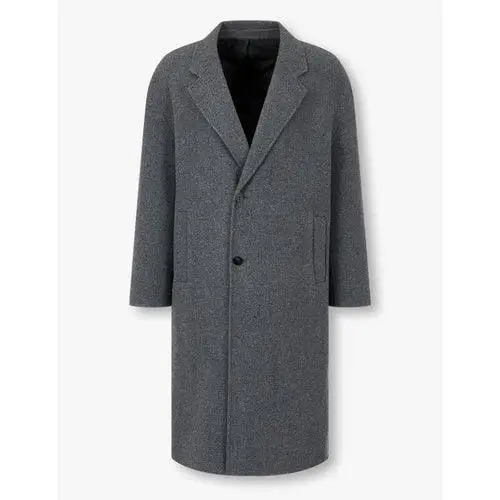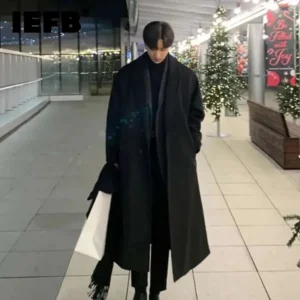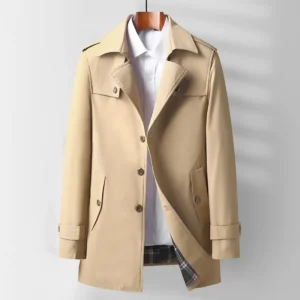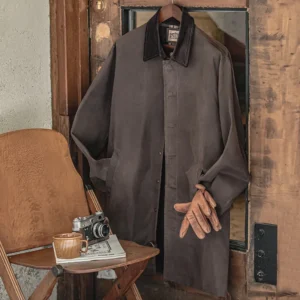Why the Right Coat Transforms Your Suit
When you step into the winter chill wearing a suit, your coat makes the first impression. Long before anyone sees your perfectly tailored suit or carefully chosen tie, they notice your outerwear. The right formal coat doesn’t just protect you from the elements—it elevates your entire professional appearance.
A quality overcoat transforms a good suit into a great ensemble, creating a polished and complete look that communicates attention to detail. Throughout history, formal coats have been essential components of professional attire, with influential business leaders and political figures using them to enhance their appearance and project authority.
The proper coat length plays a crucial role in creating this balanced silhouette. Too short, and your coat fails to protect your suit; too long, and it overwhelms your frame. Getting this proportion right is fundamental to achieving the distinguished look that quality outerwear provides.
Investing in quality formal outerwear isn’t merely a luxury—it’s a practical decision that protects your suit investment while maintaining your professional image regardless of weather conditions. The men’s overcoat collection offers timeless pieces that serve both form and function, elevating your professional wardrobe for years to come.
Classic Formal Coats Perfect for Suits
Overcoats & Topcoats: The Gold Standard
Overcoats and topcoats represent the pinnacle of formal outerwear designed specifically to complement suits. While related, these garments serve different purposes:
Overcoats are characterized by:
– Heavier construction (typically 18-24 oz wool)
– Longer length, usually falling to the knee
– Structured shoulders that accommodate suit jackets
– Superior cold-weather protection
Topcoats feature:
– Lighter weight materials (14-18 oz wool)
– Slightly shorter length, typically mid-thigh to just above the knee
– More versatile seasonal wear, ideal for fall and spring
– Often a trimmer silhouette
The most distinguished variation is the Chesterfield, featuring clean lines and sometimes a velvet collar that adds subtle sophistication. The Guards Coat, with its half-belt back, and the Covert Coat, originally designed for country pursuits, offer elegant variations for different settings.
These classic styles remain the premier choice for business and formal occasions because they’re explicitly designed to work with the proportions and structure of a suit. The men’s wool overcoat remains timeless for good reason—no other outerwear achieves the same level of formality and refinement.
Trench Coats: Sophisticated Versatility
The trench coat offers a perfect middle ground between protection and professional appearance. With its military heritage, this iconic style features:
- Water-resistant gabardine or cotton construction
- A defined belted waist creating a flattering silhouette
- Epaulettes and storm flaps that add structured detail
- Length typically reaching mid-thigh to just below the knee
The versatility of trench coats makes them ideal for transitional weather and business settings where you need protection without sacrificing style. Single-breasted versions offer a cleaner look that pairs well with modern suits, while traditional double-breasted designs provide additional protection and a more authoritative appearance.
Unlike seasonal overcoats, trench coats transition smoothly from fall to spring, making them a practical investment that works across most of the year in many climates.
Mac Coats: Minimalist Elegance
The Mac coat represents refined simplicity in formal outerwear. This clean-lined option features:
- Single-breasted, minimalist front without excessive details
- Straight silhouette without a belt
- Water-resistant properties similar to trench coats
- Mid-thigh length that works perfectly with suit proportions
What distinguishes the Mac from the trench is its streamlined appearance—no epaulettes, no belt, fewer details. This makes it particularly appealing in professional environments where understatement is valued. The Mac’s cleaner lines also make it a natural companion to modern, slim-cut suits.
These coats excel in unpredictable weather, offering protection while maintaining a polished appearance that never feels overdone or fussy.
Essential Coat Selection Principles
Proper Fit: The Foundation of Elegance
The most elegant coat in the world fails if it doesn’t fit correctly over your suit. Proper fit requires careful attention to several critical areas:
First, perform the “suit accommodation test”: When trying on a formal coat, wear a suit jacket or bring one to ensure proper sizing. Your coat should close comfortably without pulling across the chest or creating tension at the button points. Look for approximately 1-2 inches of room beyond your suit measurements.
Shoulders serve as the cornerstone of proper fit. The coat’s shoulders should align with or extend just slightly beyond your suit jacket shoulders. If the shoulder seams fall too far down your arm, the coat is too large; if they create tension or pulling, it’s too small.
Sleeve length must completely cover your suit jacket sleeves with approximately ½ inch clearance. This prevents your suit from peeking out while allowing proper mobility.
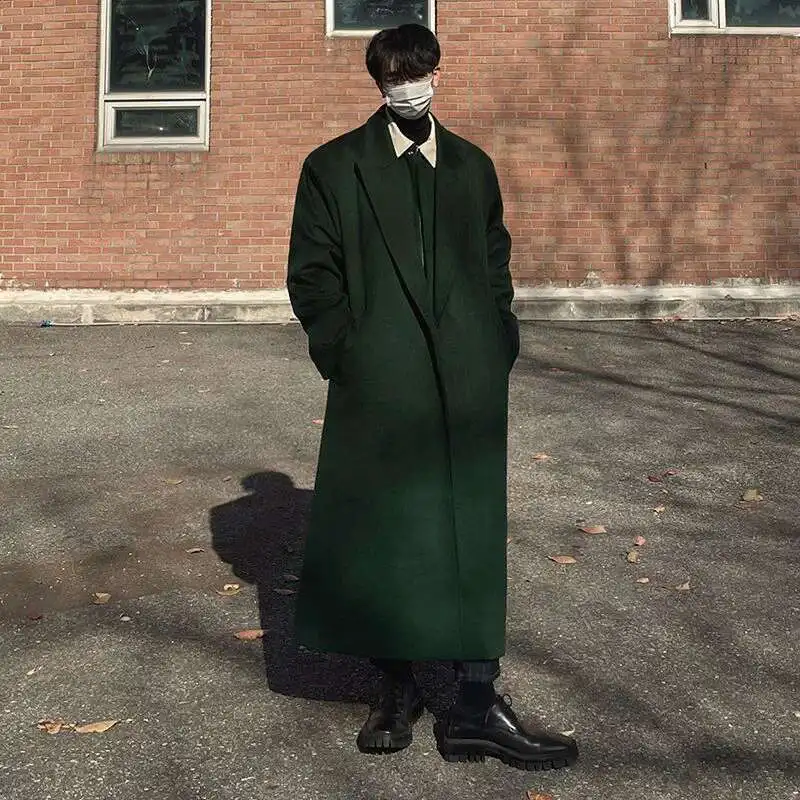
To test mobility, perform these simple movements while trying on the coat:
– Cross your arms across your chest
– Reach forward as if shaking hands
– Simulate sitting down
If any of these movements creates significant pulling across the back or arms, you need a larger size or a different cut.
The coat should drape cleanly from your shoulders without horizontal wrinkles (too tight) or excess fabric bunching (too loose), creating a smooth silhouette that enhances rather than compromises your suit’s lines.
Length Matters: Finding Your Perfect Proportion
A fundamental rule of formal coat-wearing: your coat must always extend beyond your suit jacket length. This creates the proper layered appearance and provides actual protection for your suit.
The men’s coat length guide provides comprehensive guidance, but optimal lengths vary by coat type:
- Overcoats: Traditionally knee-length or slightly below
- Topcoats: Just above the knee to mid-thigh
- Trench coats: Mid-thigh to just below the knee
- Mac coats: Typically mid-thigh
Your height significantly impacts ideal coat length. Finding the perfect coat length for your height ensures balanced proportions. As a general guideline:
- Shorter men (under 5‘8”) benefit from coats hitting just above the knee to maintain proportion
- Taller men (over 6‘2”) can wear longer coats without appearing overwhelmed
- Average heights (5‘8”-6‘2”) look best with classic knee-length overcoats
Remember that length affects formality perception—longer coats generally read as more formal and traditional, while shorter options can appear more contemporary but may sacrifice some protection.
Color Coordination Mastery
Mastering color coordination between your coat and suit creates a cohesive, thoughtful appearance. The most versatile formal coat colors include:
- Navy: Pairs beautifully with gray suits of all shades, brown suits, and other navy suits
- Charcoal: Complements navy suits exceptionally well while working with gray and black suits
- Black: Most formal option, perfect with black suits and gray suits for formal settings
- Camel: Creates striking contrast with navy and charcoal suits for a sophisticated statement
Consider two main approaches to color coordination: complementing and matching. Complementing creates visual interest through thoughtful contrast (camel coat with navy suit), while matching creates a cohesive monochromatic look (charcoal coat with charcoal suit).
When patterns are involved, follow this guideline: if your suit features a pattern, choose a solid coat in a complementary color; if wearing a solid suit, a subtle pattern in your coat (like herringbone) adds refined visual interest without overwhelming.
For maximum versatility in your wardrobe, prioritize navy or charcoal as your first formal coat purchase, as these colors work harmoniously with the widest range of suit colors.
Fabric Selection for Style and Function
The fabric of your formal coat determines not only its appearance but also its functionality and longevity. Premium wool varieties form the foundation of quality formal outerwear:
- Merino wool: Finer fibers create a smoother finish with excellent insulation
- Melton wool: Tightly woven, weather-resistant, and exceptionally durable
- Lambswool: Soft yet resilient with natural water-repellent properties
For luxury and superior warmth, cashmere overcoats offer unmatched softness and insulation at a premium price point. Cashmere blends (typically 80% wool/20% cashmere) provide an excellent middle ground, offering enhanced softness with improved durability and a more accessible price.
Fabric weight directly impacts seasonal appropriateness:
– Heavy winter weights: 20-24 oz wool for coldest conditions
– Medium weights: 16-20 oz wool for standard winter wear
– Lighter weights: 10-14 oz wool for transitional seasons
Technical considerations extend beyond warmth. Wool gabardine and cotton gabardine provide natural water resistance for trench coats and Mac coats. Some premium coats feature hidden technical elements like wind-blocking membranes without compromising their formal appearance.
Texture significantly impacts perception of formality—smoother finishes generally read as more formal, while more pronounced textures like herringbone or tweed introduce subtle visual interest while maintaining sophistication.
Design Details That Define Formality
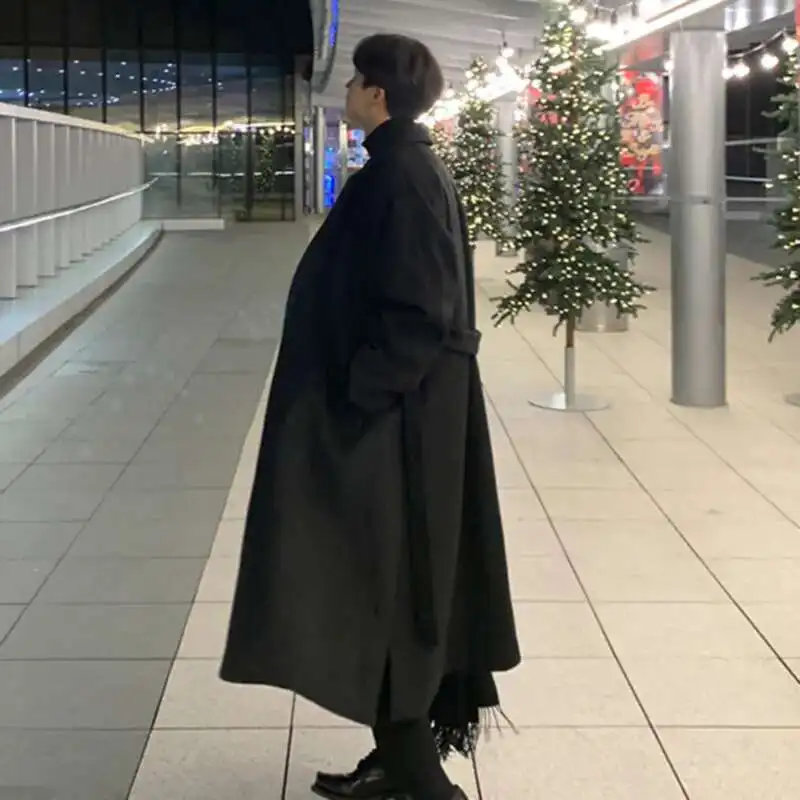
The finest formal coats distinguish themselves through thoughtful design details that enhance both functionality and elegance:
Single-breasted coats offer versatility and a cleaner silhouette that works in most professional settings. They feature a single column of buttons (typically 3-4) and provide a more contemporary look that pairs well with modern suit cuts.
Double-breasted overcoats create a bolder, more formal statement with their overlapping front panels and two parallel rows of buttons. This style evokes traditional authority and provides superior protection against cold winds. The 6×2 configuration (six buttons with two functional) remains the classic arrangement.
Lapel styles significantly impact a coat’s character:
– Notch lapels: Most versatile and common, appropriate for most business settings
– Peak lapels: More formal and dramatic, adding a distinguished touch to double-breasted styles
– Ulster collar: The most substantial option with a wider, fold-down collar designed for severe weather
Vent configurations affect both appearance and functionality:
– Center vent: Most common, provides good mobility while maintaining a clean back
– Side vents: Traditionally more formal, offering superior access to suit pockets
– No vent: Cleanest appearance but most restrictive for movement
Pocket styles follow a clear formality hierarchy:
– Jetted pockets: Most formal with their clean, nearly invisible appearance
– Flap pockets: Classic business-appropriate design offering security and style
– Patch pockets: More casual option rarely seen on truly formal overcoats
These design elements aren’t merely decorative—they evolved to serve specific functions while signaling the coat’s intended formality level and heritage.
Styling Strategies for Different Occasions
Adapting your coat choice to specific occasions ensures you’re appropriately dressed for every setting:
For business formal environments, traditional overcoats in navy, charcoal, or black represent the gold standard. When meeting with executives or clients, opt for clean lines and minimal patterns. A Chesterfield coat with its velvet collar detail adds subtle sophistication to formal business attire.
Evening formal events call for elevated options. For black tie occasions, a black or midnight blue overcoat provides the appropriate level of formality. Consider mastering formal double-breasted coats for these settings, as their structured silhouette complements formal eveningwear perfectly.
Business casual settings allow more flexibility. A camel topcoat or a well-fitted trench creates a smart appearance without seeming overdressed. These environments welcome subtle patterns like herringbone that might be too casual for the most formal settings.
Seasonal adjustments remain important. Winter formal occasions might require heavier wool overcoats, while transitional seasons call for lighter topcoats or trench coats. The core principles of fit and proportion remain consistent regardless of season.
Industry-specific considerations matter—financial and legal professionals typically adhere to more conservative coat choices, while creative fields welcome more expressive colors and patterns while maintaining professional proportions.
Mens Cashmere Overcoat, Mens Hooded Winter Coat, Mens Wool Blend Coat
Price range: $128.72 through $139.68 Select options This product has multiple variants. The options may be chosen on the product pageMens Black Overcoat, Mens Black Wool Coat, Mens Wool Overcoat
$339.18 Select options This product has multiple variants. The options may be chosen on the product pageMens Grey Overcoat, Mens Wool Blend Coat, Mens Wool Overcoat
$201.28 Select options This product has multiple variants. The options may be chosen on the product pageMens Herringbone Coat, Mens Long Overcoat, Mens Wool Overcoat
Price range: $197.16 through $203.69 Select options This product has multiple variants. The options may be chosen on the product pageMens Long Overcoat, Mens Topcoats
Price range: $189.40 through $196.88 Select options This product has multiple variants. The options may be chosen on the product pageMens Long Overcoat, Mens Tweed Coat
Price range: $397.49 through $409.96 Select options This product has multiple variants. The options may be chosen on the product page
Essential Accessories to Complete Your Look
The right accessories enhance your coat-and-suit combination while providing additional functionality:
A quality scarf serves both practical and aesthetic purposes. For maximum versatility, select fine wool or cashmere in colors that complement your coat collection. Basic folded or draped styles work well for business settings, while more elaborate knots like the Parisian or once-around add visual interest for less formal occasions.
Gloves complete the polished appearance. Leather remains the gold standard for formal settings, with these color guidelines:
– Black leather: Ideal with black, charcoal, or navy coats
– Dark brown leather: Pairs well with navy or camel coats
– Burgundy leather: Adds subtle color with navy or gray coats
For severe weather, lined leather gloves provide warmth without sacrificing style. Cashmere or wool linings offer superior insulation while maintaining a slim profile.
Traditional hats complement formal coats when appropriate. The felt fedora in black, charcoal, or navy provides classic elegance, while the more structured homburg represents the most formal option. Modern minimalist styles offer more contemporary alternatives for those hesitant about traditional hat styles.
A quality umbrella rounds out your accessories. Choose a long, sturdy model with a wooden handle for a traditional approach, or opt for a compact automatic design that fits in your coat pocket for unexpected showers.
Coats to Avoid Wearing With Suits
Not all outerwear works with suits, regardless of quality. These coat categories fundamentally clash with formal attire:
Puffer jackets, parkas, and insulated technical coats create a jarring visual disconnect with suits, regardless of color matching attempts. Their sporty silhouettes and technical materials directly contradict the refined lines of tailored clothing.
Casual coat styles that never work include:
– Duffle coats with their toggle closures
– Denim jackets of any variety
– Bomber jackets and flight jackets
– Motorcycle jackets and other casual leather styles
The problem extends beyond style conflict to practical issues—these coat types are generally too short to properly cover suit jackets, creating awkward proportions and exposing your suit to the elements.
For extreme weather conditions, better alternatives exist. Consider a traditional wool overcoat with modern technical linings or a formal dress coat in a heavier weight that provides protection without compromising style.
Care and Maintenance for Longevity
Quality formal coats represent a significant investment that can deliver decades of service with proper care:
Hanging technique matters tremendously. Use broad, shaped wooden hangers that support the shoulders properly, preventing distortion of the coat’s structure. Allow space between garments in your closet to prevent crushing and maintain proper airflow.
Regular maintenance prevents small issues from becoming major problems:
– Brush after each wearing with a soft clothes brush to remove surface dirt
– Spot clean minor marks promptly with appropriate cleaners for the fabric
– Professionally dry clean only when necessary (typically once per season)
– Allow coats to thoroughly air out between wearings
Proper seasonal storage extends your coat’s life. Before storing for summer:
– Ensure the coat is completely clean
– Use cedar blocks or lavender sachets as natural moth deterrents
– Store in a breathable garment bag, never plastic
– Keep in a cool, dry location away from direct sunlight
The principles of long-term leather coat care apply similarly to wool coats—minimal cleaning, proper storage, and prompt attention to issues preserve their appearance and function.
Small repairs made promptly prevent larger problems. Replace buttons before they fall off, repair small seam separations immediately, and address lining tears before they expand.
Is a Peacoat Ever Appropriate Over a Suit?
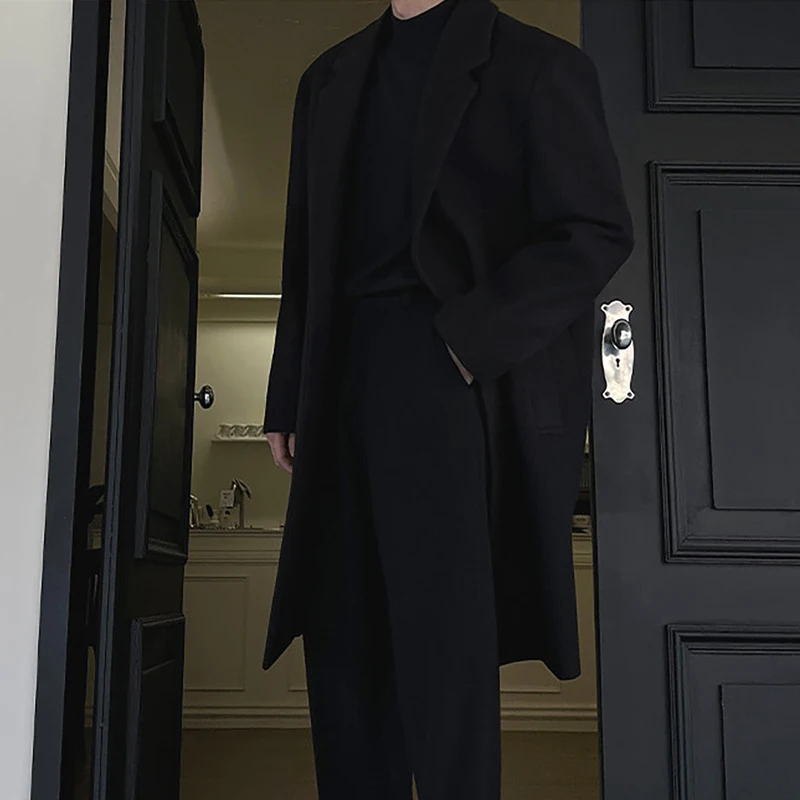
Traditional wisdom says peacoats and suits don’t mix, but modern interpretations have created some exceptions to this rule.
In less formal business environments, a properly proportioned peacoat can work with a suit if it meets these specific criteria:
– Extended length that fully covers the suit jacket (longer than traditional peacoat design)
– Refined wool construction without excessive bulk
– Tailored fit with clean lines rather than boxy silhouette
– Darker, solid color (navy being the most appropriate)
The peacoat-suit combination works best with modern, slim-cut suits rather than traditional full-cut suits. The proportions align more harmoniously when both elements feature a trimmer silhouette.
However, for traditional business formal settings, client meetings, or important presentations, stick with classic overcoats or topcoats. The peacoat, despite modern refinements, still carries a more casual heritage that makes it inappropriate for truly formal business occasions.
Quick Reference: Coat and Suit Harmony Checklist
Use this checklist to ensure your coat and suit pairing hits all the right notes:
- Does the coat fully cover your suit jacket by at least 2-3 inches?
- Can you comfortably button the coat over your suit without pulling?
- Do the shoulders align properly without significant overhang or tightness?
- Does the sleeve length cover your suit jacket sleeves completely?
- Is the coat appropriate for the formality level of your destination?
- Does the coat color complement or appropriately match your suit?
- Is the fabric weight suitable for the current season?
- Are all visible elements (buttons, lining) in good repair?
- Do your accessories (scarf, gloves) coordinate with both coat and suit?
- Does the overall silhouette create a clean, proportional appearance?
This simple verification process takes just moments but ensures you present a thoughtfully coordinated appearance.
Balancing Weather Protection and Style
Sometimes practical weather concerns challenge formal ideals. In extreme conditions, these strategies help maintain professionalism:
Layer strategically with thin, insulating materials beneath your suit rather than choosing a bulkier coat. Merino base layers and lightweight technical vests add warmth without changing your coat’s fit over your suit.
Look for hidden technical features in formal coats, such as wind-resistant membranes, water-repellent treatments, or strategically placed insulation panels. These modern innovations preserve traditional appearance while adding practical protection.
In truly extreme conditions where function must take precedence, opt for the most formal version of necessary weather protection. A knee-length wool overcoat with substantial weight will handle most winter conditions while maintaining appropriate formality.
For rain protection, a classic trench coat with sealed seams offers the best combination of weather resistance and professional appearance, proving that practical solutions need not compromise your professional image.

